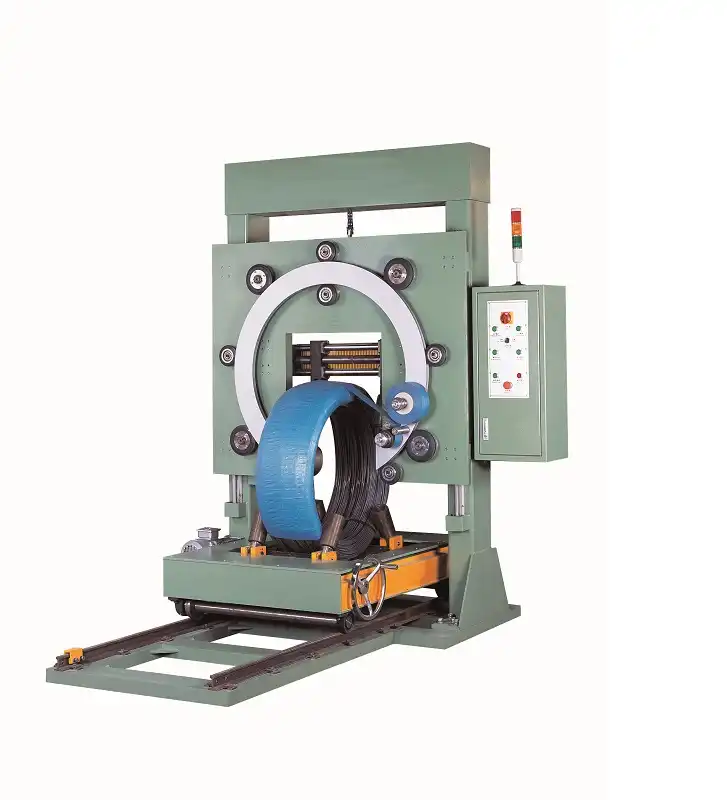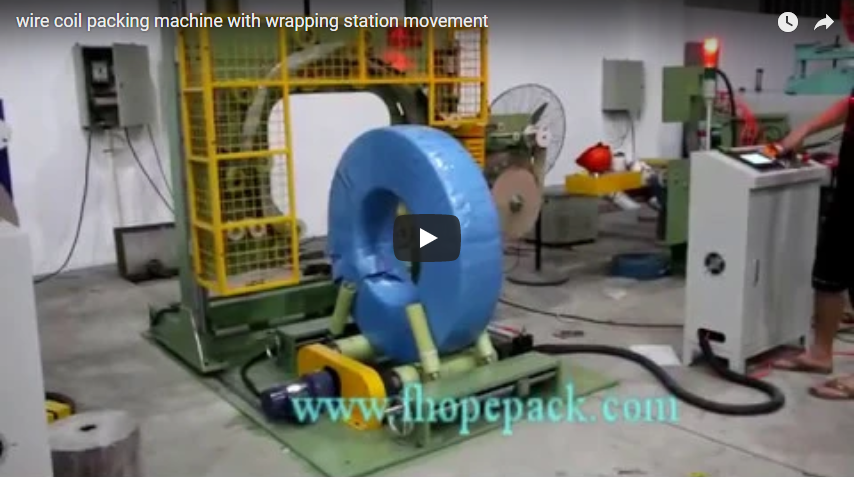Revolutionizing Wire Packaging: A Deep Dive into the Moving Station Coil Wrapping Machine
Handling and packaging large, often heavy, wire coils presents unique challenges for manufacturers and distributors. Ensuring product integrity during transit and storage, optimizing labor, and maintaining operational efficiency are paramount. The wire coil packing machine, particularly models featuring a moving wrapping station, represents a significant advancement in addressing these needs.
Let's explore the technical capabilities and practical benefits of this automated coil packaging solution.
1. The Core Challenge: Securely Packaging Bulky Coils
Wire coils, whether steel, copper, aluminum, or other materials, are often bulky, heavy, and susceptible to environmental damage (like moisture and dust) or physical damage during handling. Manual packaging is labor-intensive, slow, and can lead to inconsistent wrap quality, potentially compromising the product. Achieving a tight, uniform wrap around the entire coil surface, including the inner and outer diameters, is crucial.
2. Introducing the Solution: The Moving Station Advantage
A wire coil packing machine automates the process of applying protective wrapping material, typically stretch film, around the coil. The key differentiator of the model discussed here is its moving wrapping station. Unlike simpler orbital wrappers where the coil might move through a fixed ring, here the wrapping mechanism travels along the length or axis of the stationary or indexed coil.

3. How It Works: A Technical Perspective
The operational sequence typically involves:
- Loading: The wire coil is placed onto the machine's designated loading area, often equipped with rollers or a conveyor system.
- Positioning: The coil is positioned correctly for the wrapping cycle to begin.
- Wrapping Cycle Initiation: The operator starts the cycle via a control panel (often PLC-based with an HMI).
- Wrapping Station Movement & Film Application: The wrapping station, holding the stretch film roll and pre-stretch mechanism, begins its traverse along the coil's axis. Simultaneously, the film is dispensed and applied orbitally around the coil's cross-section.
- Uniform Coverage: The synchronized movement of the wrapping station ensures the stretch film overlaps consistently, providing complete coverage and a tight, secure wrap.
- Film Cut & Seal: Upon completion of the programmed wraps, the machine automatically cuts and seals the film tail.
- Unloading: The fully wrapped coil is ready for removal or transfer to the next stage (e.g., palletizing, storage).
4. Key Technical Parameters & Customization Potential
These machines are not one-size-fits-all. Key specifications often include:
- Coil Dimensions:
- Outer Diameter (OD): Max/Min supported
- Inner Diameter (ID): Max/Min supported
- Width/Height: Max/Min supported
- Weight: Maximum load capacity
- Wrapping Material:
- Film Type: Stretch Film (LLDPE), potentially VCI film, paper, or other materials depending on machine design.
- Film Roll Width: Standard supported widths.
- Film Roll Diameter: Max outer diameter.
- Performance:
- Wrapping Speed: Adjustable (e.g., RPM of the ring, traverse speed).
- Overlap Rate: Adjustable percentage for varying levels of protection and stability.
- Cycle Time: Dependent on coil size and wrapping parameters.
- Control System:
- PLC Brand (e.g., Siemens, Allen-Bradley, Omron).
- HMI (Touch Screen Interface) for parameter setting and diagnostics.
- Programmable wrapping cycles.
- Power Requirements: Voltage, phase, frequency.
- Optional Features: Top press devices for unstable coils, integrated weighing systems, safety fencing, automated loading/unloading systems.
The ability to adjust wrapping tension, speed, film overlap, and station movement speed allows businesses to fine-tune the packaging process for different coil types and protection requirements.
5. Tangible Benefits: Elevating Your Packaging Operations
From our experience helping clients integrate these systems, the advantages translate directly into business value:
- Enhanced Product Protection: The consistent, tight wrap shields coils from moisture, dust, dirt, and abrasion during handling, shipping, and storage, reducing product damage and claims. The moving station ensures even protection across the entire coil face.
- Operational Efficiency & Speed: Automation drastically reduces the time required to package each coil compared to manual methods. This boosts throughput and allows for faster order fulfillment.
- Consistent Quality: Automated wrapping eliminates human variability, ensuring every coil receives the same level of high-quality, professional-looking packaging. This enhances brand perception.
- Labor Savings & Improved Safety: Reduces the need for manual labor in a physically demanding task, freeing up personnel for higher-value activities. Automation also minimizes ergonomic risks associated with manually handling large rolls of film and wrapping heavy coils.
- Material Optimization: Advanced pre-stretch systems (often stretching film up to 250-300%) maximize film yield, reducing material consumption and packaging costs per coil.
6. Real-World Application & Insights
We've seen these moving station wire coil packers successfully implemented across various sectors:
- Wire & Cable Manufacturing: Packaging coils of steel wire, copper wire, aluminum cables, and fiber optic cables.
- Steel Industry: Wrapping steel coils, wire rod coils.
- Building & Construction: Securing coils of reinforcement wire, conduit, or tubing.
- Logistics & Distribution: Repackaging or securing coils for onward distribution.
What truly sets these machines apart in practice is their ability to handle diverse coil sizes effectively while ensuring complete protection. Clients often report significant reductions in packaging time (sometimes cutting it by over 50%) and noticeable improvements in load stability for transport.
7. Making the Right Choice
When considering a wire coil packing machine with a moving station, focus on:
- Your Coil Range: Ensure the machine specs comfortably cover your smallest and largest, lightest and heaviest coils.
- Required Throughput: Match the machine's speed and cycle time to your production or shipping demands.
- Level of Automation: Determine if you need a standalone machine or integration into a larger automated line.
- Reliability & Support: Consider the manufacturer's reputation, warranty, and availability of technical support and spare parts.
Conclusion: A Strategic Investment in Packaging Excellence
The wire coil packing machine with wrapping station movement is more than just equipment; it's a strategic investment in efficiency, product protection, and operational safety. Its ability to deliver consistent, high-quality wrapping tailored to specific needs makes it an indispensable tool for industries handling wire coils. By automating this critical process, businesses can reduce costs, enhance productivity, and ensure their products reach their destination in pristine condition.
For more detailed information on coil packing solutions:
https://www.fhopepack.com/Coil_packing_machine.html
Contact us for inquiries:
info@fhopepack.com


